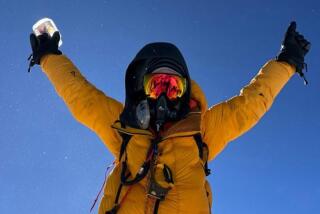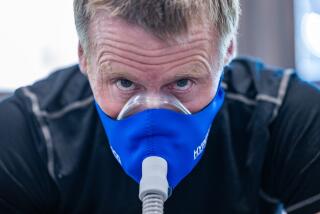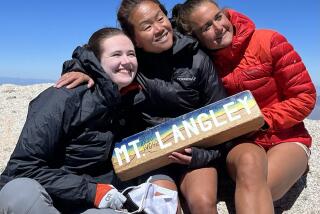South Korean’s uphill climb, on and off the mountains
- Share via
Reporting from Seoul — At some point, on every snow-covered mountain she climbs, Oh Eun-sun gazes down as though from the heavens. But rather than embracing euphoria, she’s trapped in a spirit-crushing physical hell.
Her legs wobbly, her lungs screaming for oxygen, she feels like she could just lie down and die. But she doesn’t. She pushes on.
“With every move, I feel like quitting,” she says. “I am so exhausted. I ask myself, ‘Why am I doing this?’ It’s just too hard.”
At 5-foot-1, she looks more like a gymnast than a stubborn scaler of mountains. But earlier this year, Oh joined the topmost ranks of mountain climbing — an elite group that until now was exclusively male.
In late April, the 44-year-old former government worker became the first woman to scale the planet’s 14 highest peaks — all of them over 26,000 feet and located in the Himalayan and Karakoram mountain ranges — narrowly beating three European women for the record.
Though hailed as a hero in South Korea, Oh says she has learned a bitter lesson about her endurance sport: Along with capricious storms and thin air, jealousy and resentment often await at the highest Himalayan altitudes.
Oh’s record has provoked an avalanche of criticism. Her use of oxygen tanks and her reliance on Sherpa guides break unwritten rules of the sport, some say. Others dispute that Oh even reached the peak of Kanchenjunga on the border between India and Nepal, the world’s third-highest summit, suggesting her victory photograph was taken somewhere below the top.
Oh, they say, is a cheater.
“In my eyes, it’s no longer mountain climbing if you use an oxygen mask. It’s as if someone used a motorcycle in the Tour de France,” professional climber Hans Kammerlander, who has scaled 12 of the top 14 peaks, told a German magazine. “The only way she could have done it with any less sportsmanship would have been if she had simply flown straight to the summit by helicopter.”
The controversy, many say, raises questions about fair play on both sides. Are Europeans so protective of their traditional success in alpine sports that they would attack an unlikely champion from Asia? Or is Oh the product of a hyper-competitive South Korean culture marked by such scandals as cheating on college entrance exams and the 2006 case of scientist Hwang Woo-suk, who faked groundbreaking stem cell research?
“It’s heartbreaking,” Oh says of criticism from some female climbers whose exploits inspired her. “But I’m also human. How could I not be angry?”
*
Even as a child, Oh was fascinated by mountaintops, the places where snow and ice never melt.
In 1993, as an avid amateur climber, she won a spot on the Korean Alpine Federation team to climb Mt. Everest, the world’s tallest mountain, which lies on the border between Nepal and Tibet.
Despite months of training, she was too weak to finish. Angry at herself, she quit her job and focused full time on her obsession. But the mountains would deliver another comeuppance.
In 2001, after failing to reach the top of mighty K2, on the Pakistan-China border, she decided to challenge lesser peaks.
But ambition gnawed at her. She couldn’t get the idea of climbing the world’s tallest mountain out of her head. And so she trained her body to its limit. Three years later, in 2004, she returned to Everest and this time reached the pinnacle. That’s when she set a goal to scale Earth’s 14 highest peaks.
Slowly, Oh built endurance, learning to control her pace and conserve energy. One by one, she scratched off the names of formidable foes: Makalu. Lhotse. Manaslu.
The mountains did not yield easily. She took dangerous falls and dodged tumbling sheets of ice. Near the summit of Everest, she found the body of South Korean climber Park Moo-taek, who only hours before had become separated from his team.
“He looked like a sleeping baby,” she recalls. “His face should have been frightful, tormented. But he looked so comfortable. I couldn’t stop crying. I knew him. I’d just seen him at the base camp. I stared death in the face that day.”
In April, when she reached the highest peak of Annapurna in Nepal, she carried a photo of Ko Mi-young, a lifelong rival and friend who fell to her death last year while descending from Nanga Parbat in Pakistan.
Weeping, crawling on all fours up Annapurna’s steepest final ascent to set the record, Oh cast her arms toward the sky and shouted: “Thank you! Thank you!”
“We don’t beat mountains. They open up and let us in,” she says. “When you reach the top, you have to give thanks to the mountain for allowing your climb.”
*
For months, there were private mutterings among some of Oh’s rivals that she didn’t play fair. The doubters went public after she reached the top of 28,169-foot-high Mt. Kanchenjunga last summer.
A rival South Korean climber produced a photograph of the mountaintop, buried in snow and ice, that he said was proof that Oh’s victory photo — showing bare rocks — was taken somewhere below.
Oh says she’s sure she reached the summit, despite fog and a violent storm. But other climbers, including Spaniard Edurne Pasaban, who accomplished her goal of climbing all 14 peaks just weeks after Oh did, went on the record with their accusations.
Embarrassed, Oh avoided the public. She prayed for days at a Buddhist temple. Then she fought back.
In December, she held a news conference in Seoul along with her financial sponsors — who continue to support her — and produced a Sherpa who attested that Oh had climbed Kanchenjunga to the top.
Oh concedes some points. She has used oxygen tanks, but she insists that this is an accepted practice among most climbers. She also once took a helicopter to a base camp to beat an impending storm.
Still, Elizabeth Hawley, widely regarded as the authoritative chronicler of Himalayan expeditions, has described Oh’s ascent of Kanchenjunga on her online Himalayan Database as “disputed.”
Hawley, 86, an American and a former journalist, is based in Katmandu, Nepal. Oh recently went there to meet with Hawley and offer evidence of her achievement.
“I have no problem with her style,” Hawley said of Oh. “She used oxygen and took a helicopter to base camp. So what? The point is, did she get to the top or not? It’s not how she got there — unless she took a helicopter the entire way.”
For now, Hawley said, the “disputed” notation will stand until she completes her investigation.
Oh admits she may have inadvertently contributed to the controversy. “I should have explained my climbing style,” she said. “I understand it was surprising when I was the first to finish. It was surprising to me too.”
For now, she said, she needs rest before she embarks on her next ascent.
“I don’t know why I continue to climb mountains,” she said. “I just do.”
Researcher Ju-min Park of The Times’ Seoul Bureau contributed to this report.
More to Read
Sign up for The Wild
We’ll help you find the best places to hike, bike and run, as well as the perfect silent spots for meditation and yoga.
You may occasionally receive promotional content from the Los Angeles Times.







